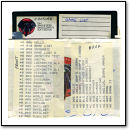 “Try new metal puddin’ pops!”
“Try new metal puddin’ pops!”
When looking at the Texas Instruments CC-40’s capabilities, one wonders why companies even bothered in making tiny portable machines like this one (see also the Epson HX-20, HP-75C, and TRS-80 Pocket Computer, among others) in the early 1980s.
Sure, each one came equipped with a gee-whiz wow factor, but most of these diminutive PCs proved impractical to actually use. Limited memory, restrictive and unreliable data storage, and tiny LCDs capable of displaying either one or a few lines of text almost ensured that these products would remain technological novelties.
(As an aside, the only computer of this circa-1983 portable class that I find to be practical and truly useful was the TRS-80 Model 100, which many journalists relied on for decades)
After giving the question considerable thought, I recently realized why they did it. Companies like TI spent untold millions upon millions of dollars on R&D, design, tooling, and production, distribution, and marketing so that collectors of vintage computers, like me, would one day have more and varied specimens to collect.
To those companies, I say this: Thank you for wasting your money to make my hobby more fun.
See Also: Bill Cosby Fondles a TI-99/4A (Retro Scan, 2006)
[ From Popular Computing, June 1983, p.129 ]
Discussion Topic of the Week: What’s the smallest vintage computer you’ve ever used?











